
Portable Surgical Kits Page Menu: 1 2 3 4 5 6 7 8 9 Next>>
Portable Surgical Kits From the Golden Age of Piracy, Page 6
Portable Instrument Kits
There are three types of portable instrument kits named in the various sea
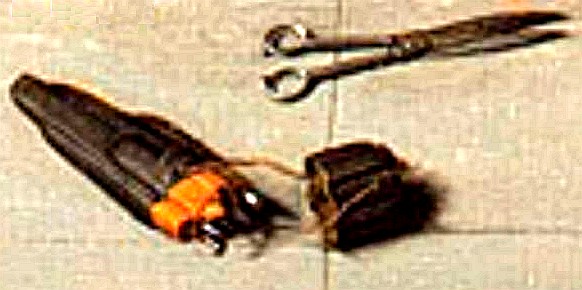
Artist: Isaack Koedijck - Early Portable Instrument Kit, From Barber-Surgeon Tending a Man's foot (1649-50)
surgeon's books. The first two were the pocket kit and the plaster box. The third was a barber's kit, which is only mentioned specifically by sea surgeon John Woodall and encyclopedist Randle Holme. The primary focus here will be on the instrument kits, although the barber's kit will also be briefly discussed.
The portable instrument kits appear to have grown out of another type of small instrument case, whose form is specifically designed to house some of the more unusually shaped instruments such as scissors and forceps as well as the more regularly shaped ones some time during or before the 15th century. This kit is sometimes shown with a strap so that it could either be hung up (as is shown in the image below right.) or perhaps hung over the surgeon's neck in the manner described by French surgical instructor Pierre Dionis as the surgeon having a "Purse or Pocket fastn’d before him" during a lithotomy.1
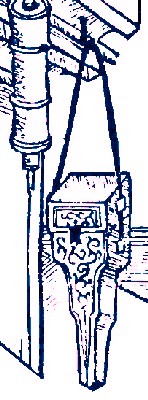
Artist: IHieronymus Brunschwig
Early Instrument Case, From
Das Buch der Cirurgia (1497)
Such a case was in the possession of the Worshipful Barbers of London, formerly the Company of Barbers and Surgeons, which oversaw the surgeons who embarked from London (and to a degree, all of England) during the golden age of piracy. Jesse Dobson, archivist to the company in 1979, and Robert Milnes Walker described this early 16th century kit in some detail in their book.
This case, which is gilded in parts and richly enameled, is 18 cm [7 inches] long and 6 cm [2-3/8 inches] by 5 cm [2 inches] in section, tapering slightly to the base. It is lined with wood and leather and has two chains held at their ends by rings which are passed through the mouths of lion masks and pass through similar rings attached to the cover. It bears the Royal Arms of King Henry VIII, enameled in colour, the supporters being a greyhound and a dragon as used by Henry VII and Henry VIII up to 1525. The front of the case bears the Arms of the Barber-Surgeons' Company as granted in 1451, and the figures of Saints Cosmos and Damian, the patron saints of the Fellowship of the Surgeons, on each side and below this the cognisance granted to the Fellowship in 1492. At the sides are figures of Saints John and Catherine, while on the back are engravings of St. George and the Dragon and of the Martyrdom of Thomas Becker.2
The purpose of such an ornate kit was likely more ceremonial than practical. Dobson and Walker speculate that it was likely a royal gift given by King Henry when he granted the barber-surgeons their charter in 1512.3 Although the images shown here are not quite as elaborate as the one they describe, they are similar in basic design. Images of the kit held by the Worshipful Barbers of London can be found in Dobson and Walker's book.
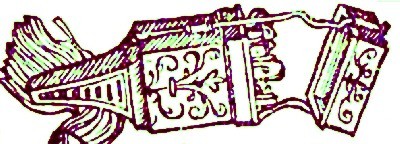
Early Instrument Case With Top Open, From Wundartzney zu allen gebrechen
des
gantzen Leib,
By Johannes Charetanus (1531)
This style of portable instrument kit appears to have given way to a smaller and slightly more practical design sometime between the mid-16th and mid-17th century. This instrument kit had a hinged lid and would sit flat on a table. Every sea surgeon who wrote about surgery at sea (including fiction author and former sea surgeon Tobias Smollet)4 just before and and during the golden age of piracy mentions either the pocket kit or plaster box, which is about as strong a form of support you can expect to find for a medical item at sea. Even Lionel Wafer, the prematurely-promoted surgeon to the buccaneers, mentions such an instrument kit5 as we shall see.
1 Pierre Dionis, A course of chirurgical operations: demonstrated in the royal garden at Paris. 2nd ed., 1733, p. 116; 2 Jessie Dobson, Archivist to the Company & Robert Milnes Walker, Past Master, Barbers and Barber-Surgeons of London, 1979, p. 106-7; 3 Dobson & Walker, p. 107; 4 See John Atkins, The Navy Surgeon, 1742, p. 148, John Moyle, Chirugius Marinus: Or, The Sea Chirurgeon, 1693, p. 46, John Woodall, the surgions mate, 1617, p. 17-8, 25-26 & Tobias Smollett, The Adventures of Roderick Random, 1748, p. 40; 5 Lionel Wafer, A New Voyage and Description of the Isthmus of America, 1903, p. 55
Portable Instrument Kits: The Plaster Box
"And when a little time thereafter the said chirurgeon went aboard the said ship the Worcester, he perceived
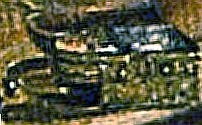
Artist: Gerrit Lundens
Plaster Box Detail, From Surgeon attending
a chest wound, Wellcome (17th c.)
the deck thereof lumbered and covered, and in a confused manner, with balls, boxes, and goods; whereof when he asked the reason, John Madder, one of the pannels, and a principal actor in the engagement, answered, ‘Damn you, what have you to do to enquire? Meddle with your plaister-box.'" (“The Trial of Captain Thomas Green and his Crew, at the High Court of Admiralty of Scotland, for Piracy”, A Complete Collection of State Trials, Vol. XIV, p. 1212)
The plaster box was such a common accoutrement of a surgeon that it was the first thing that came to the minds of the mutineering pirates who captured the Worcester in 1705. They used it to summarily dismiss the ship's sea surgeon Charles May and his unwanted questions in the quote leading this section. University of Wolverhampton Doctors Nancy Cox and Karin Dannehl explain that a plaster box is not a box made of plaster but "a complete kit for a surgeon"1. Navy surgeon and historian John Kirkup was a little more modest in his description, noting that it contained a "basic first-aid kit"2 with the instruments needed to treat new wounds as well as the plasters used to cover the wound once it was cleaned and prepared.
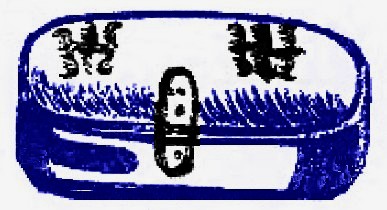
Simple Sketch of a Plaster Box, From The academy of armory, Book III,
By
Randle Holme,
p. 438 (1699)
Encyclopedist Randle Holme has a very basic image of what he calls a plaster box in his book (seen at left). He describes it as "a Chirurgions Plaster Box with the Lid shut [the color of] Azure [bright blue], Varnished and [with a] Lock and hinges, [of] Argent [silver]."3 He goes on to explain that the box has three parts the first of which is "The Box it self, in which lyeth such Instruments as serve for present use, which are small ones only"4. As already mentioned, these boxes were about four and a half to six inches long5, so the instruments had to be slightly shorter than that.
Holme considered the second part of the plaster box to be the "Box Lid in which is placed a loose Lid or cover, under which in the said place is kept the Lint of which Surgeons use both for the cleaning of Wounds, as also to make Tents and Plagets [pledgets], to lay in or upon deep Sores, before the Plaster is put on."6 From this we learn that the plaster box has bandaging materials tucked into the lid which would be used to cover and treat new wounds. (Tents were soft pieces of fabric placed inside wounds to keep them open. Pledgets were soft pads placed directly on wounds.
The third part of the plaster box was a "Drawer at the bottom of the Box, in which are kept all the Plasters ready made, and are for any sudden occasion"7. Holme then goes on to list several plasters found in the box. A plaster or
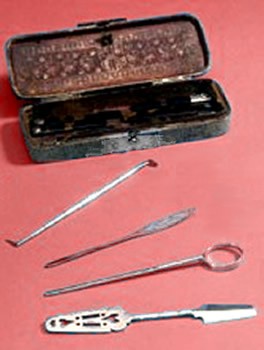
Photo: Dan Underhill, Used With Permission
Plaster Box With No Drawer & Instruments (Late 17th )
'emplaster' refers here to "a Medicine applied outwardly to the Skin, spread upon Linnen, or Leather"8. Plasters were made of oils, grease, gums, powders and waxes. They were "of a like consistence with Wax; as Rosin, Pitch, Gum, &c, the Mass whereof being yet Hot, is formed into a Cylindrical Figure"9. If this were done, the plaster 'cylinder' could be easily and compactly stored in the plaster box drawer. This 'solid' plaster then had to be made fit for use on a wound. How this could be done is explained by surgeon Felix Würtz, who recommended that a plaster, "being hard, you may fling it into hot Water to soften it."10 However, most surgical authors seemed to recommend spreading the plasters on cloth and storing them that way as we shall see.
In addition to plaster boxes with small drawers in the bottom, there were very similar boxes without a drawer, such as the one seen at right. As mentioned previously, the difference between the terms 'plaster box' and 'pocket kit' may have been nothing more than personal preference on the part of surgical writers given the lack of rigor in terminology during this time. However, it seems quite possible that a plaster box without the necessary drawer to house the plasters would lend itself to the term pocket kit. The term 'Plaster box' may also have given way entirely to the term 'pocket kit'. When discussing plaster boxes, historians Cox and Dannehl state that "The term seems to have died out, and has not been noted after 1701"11. Perhaps it was more a shift in lexicon than a change in box type.
Terminology aside, several sea surgeons mention plaster boxes in their writings. At the beginning of his seminal work, John Woodall listed everything that a sea surgeon would need to bring with him, which included "The Plaster boxe furnished with the due instruments and medicines thereunto belonging."12 Although he does not call specifically for a plaster box, fellow sea surgeon John Atkins advised his readers that "in War, the Surgeon always should have Boxes of Dressings ready"13.
After sea surgeon James Yonge's ship Bonaventure was captured by the Dutch in
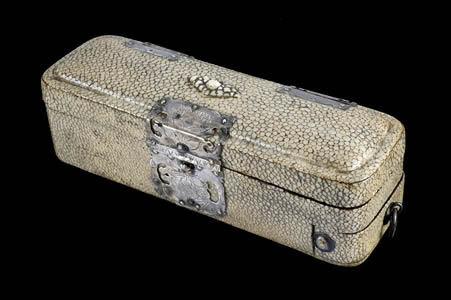
Shagreen Surgical Instrument Case With Silver Ornaments, Wellcome Collection (1650-85)
January of 1666, he was imprisoned and had all of his belongings taken from him. John Shepherd, a friend of Yonge's father, offered to petition the jailers on Yonge's behalf. Yonge asked him to get his plaster box back from them so that he could assist prisoners who were ill. "My box was a plain thing and had but 3 silver instruments. He brought me a fine new Nisle skin box, that he took from the chyrurgeon of the Swiftsure who died in the prison. I innocently said it was not mine, then he fetched the other, which I took, kissing his hand, bid him farewell."14
There are a couple of points worth highlighting in Yonge's narrative. First, he says he only had three silver instruments in his plaster box. The average number of instruments found in a plaster box is about 8 based on the texts from the period, so It seems likely that he also had other instruments which were not silver in there. If so, this hints at the less expensive types of instruments young sea surgeons may have had. Second, the more ornate box which Shepherd first brought him was covered in Nisle skin which, according to editor F. N. L. Poynter's footnotes, was crocodile skin. Marine animal skin was a popular covering for plaster boxes based on extant plaster boxes. The popular shagreen covering was made either from shark or ray skin. Historian John Kirkup explains, "In the eighteenth century, fish skin was applied commonly to cover instrument pocket cases and was replaced in the nineteenth century by calf and fine leather."15
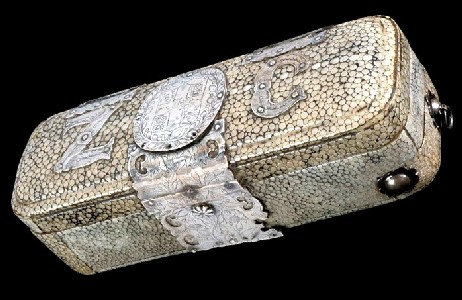
Another Shagreen Surgical Instrument Case With Silver Ornaments and the
Barber-Surgeon's Company Coat-of-Arms, Wellcome Collection (1650-85)
It is interesting that the skin-covered boxes were considered more precious than Yonge's 'plain thing' whose surface isn't identified. It may have been just the underlying wood which made up the structure of most plaster boxes.
The Dutch also had a version of the plaster box which they called lapdoos, a word which means 'rag box'. The Dutch East India Company started using them in 1682 "as a measure to combat the theft of medicines from the big medicine chests."16 Apparently some of the VOC's surgeons were taking medicines from the chest that had been purchased by the company for a voyage and selling them before their ship even left port. "The lapdoos was used mainly while the ship was still in harbour and contained only some small quantities of basic medicines and some linen."17 This is a bit different than the plaster box in that it appears to have contained no instruments.
1 Nancy Cox and Karin Dannehl, "Dictionary of Traded Goods and Commodities 1550-1820," british-history.ac.uk, gathered 11/15/16; 2 John Kirkup, "Introduction", The Surgions Mate, 1978, p. xvii; 3,4 Randle Holme, The academy of armory, Book III, 1688, p. 438; 5 Elizabeth Bennion, Antique Medical Instruments, 1979, p. 277; 6,7 Holme, p. 438; 8,9 Steven Blankaart, The Physical Dictionary, 4th ed, 1702, p. 119; 10 Felix Würtz, The Surgeons Guid Or Military and Domestique Surgery, 1658, p. 150; 11 Cox and Dannehl, "Dictionary of Traded Goods and Commodities 1550-1820," gathered 11/15/16; 12 John Woodall, "The particulars of the Surgeons Chest", the surgions mate, 1617, Not paginated; 13 John Atkins, The Navy Surgeon, 1742, p. 148; 14 James Yonge, The Journal of James Yonge [1647-1721] Plymouth Surgeon, 1965, p. 99-100; 15 John Kirkup, The Evolution of Surgical Instruments; An Illustrated History from Ancient Time to the Twentieth Century, 2005, p. 79; 16,17 Iris Bruijn, Ship’s Surgeons of the Dutch East India Company, 2009, p. 68
Portable Instrument Kits: The Plaster Box's Tools
Six authors mention the contents of the plaster box in their text. They are listed in the chart below along the left side. They are listed in order from the author mentioning the fewest instruments (Felix Würtz with three) in increasing order to the one mentioning the most instruments (Randle Holme with fourteen). The instruments included by each author in their plaster box are listed along the top
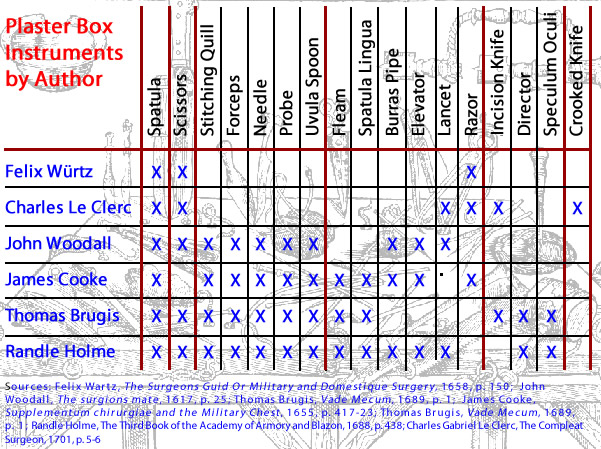
axis in order of decreasing popularity. There are seventeen unique instruments mentioned by the six authors. A red vertical line indicates a change in the number of authors who supported the inclusion of instruments. (For example, the spatula is included by all six authors, so a red lines separates it from the scissors which is included by five of them.)
Felix Würtz's three mentioned instruments seems very low, most likely because his list is incomplete. He explains that the surgeon's box should be "filled with necessaries, viz. Raisor, Spatule, Sheers"1. If the unusually low number of instruments included by Würtz are removed from the count, the average number of instruments found in a plaster box increases from 8 to 9.
It is also interesting that the author who recommends the largest number of instruments is the only one who is not a surgeon. Randle Holme was a researcher, who created a catalog of items and symbols related to heraldry. He may have relied on evidence from surgeons or their books on the topic to create his list. This may also explain why everything he mentions is also included by at least one other author.
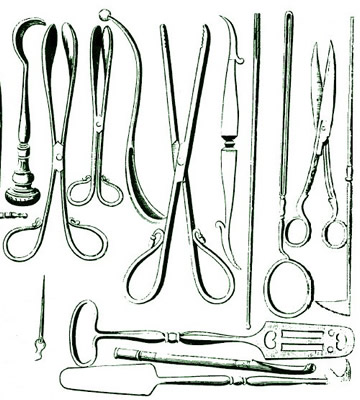
Plaster Box Surgical Tools, From Mellificium Chiurgiae,
By James Cooke, p. 117 (1685)
It was previously suggested that Thomas Brugis' book was somewhat derivative, particularly of John Woodall's book. However, only seven of his twelve instruments (58%) found in the plaster box are shared with Woodall. He clearly had his own thoughts on what would best be used for first aid in the plaster box.
Most of the tools in this list are fairly general purpose instruments such as the scissors, spatulas, forceps, probes, elevators and a razor. Other popular instruments were for treating simple wounds including the stitching quill, needles and burras pipe. Fleams and lancets used in bloodletting were also well supported which should not be surprising given the frequency with which that operation was performed. There is less support for instruments used to cut the skin such as the incision knife, crooked knife and director. Such an operation would more likely be performed in a formal setting where the surgeon had sufficient light, assistance and a solid operating surface under the patient. Several authors spoke out against cutting the skin unless it was absolutely necessary which may also explain their limited support. The speculum oculi is used only in operations of the eye which were delicate procedures which may be why only a single author includes it.
A couple of authors mention proper maintenance of the instruments when discussing them. Felix Würtz advises his readers to "keep the [plaster] box clean that you may in nothing be hindred"2. By 'clean', his concern seems to be that the box not be cluttered with instruments and bandaging materials; that way the surgeon could quickly find the tools he needed in an emergency. Thomas Brugis is more direct, stating that he surgeon should "be provided with an handsome Emplaster Box, furnished with these Instruments following, always kept bright and sharp"3.
1,2 Felix Würtz, The Surgeons Guid Or Military and Domestique Surgery, 1658, p. 150; 3 Thomas Brugis, Vade Mecum, 1689, p. 1
Portable Instrument Kits: Plasters in the Plaster Box
In addition to recommending the tools that should be kept in the plaster box, the surgeons also suggested which plasters would be most useful in this rapid response kit. Just as they had differing opinions on which tools would be best,
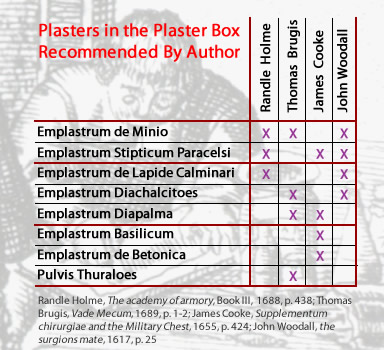
so they had a variety of suggestions for which plasters should be kept ready for action. Four authors suggest plasters that should be put in the plaster box which are shown in the chart at left. Here the plasters are listed vertically and the authors recommending them are shown horizontally. Like the instruments, the plasters are listed from the most recommended first and then in decreasing order by popularity among the authors. Horizontal red lines indicate a change in the number of authors who recommend that group of plasters.
Each of the three surgical authors suggest four plasters, while encyclopedist Holme lists only three. However, the three surgeons do not specifically suggest carrying all four of the plasters they mention in their list. Some of the plasters they suggest are simply possible alternatives to other plasters.
For example, Thomas Brugis suggests having either Diapalma plaster or Emplastrum de Minio as well as suggesting either Diachalcitoes plaster or Emplastrum de Minio.1 John Woodall similarly advises, "The Plaster boxe ought to containe at the least three kindes of several Emplasters as namely, Emplast. Stipticum Paracelsi, Diachalcitheus. de lapide calaminare. For want of Diacalsithios, Emplast. de minio may serve."2 Emplastrum de Minio appears to have been a backup for both of the surgical authors who included. So its strong position in the above chart may be a little misleading since two of the three authors who list it suggest it list it as an alternative.
Like Woodall, James Cooke states that the plasters "are to be of three sorts at least" recommending that the surgeon include "Betonica or Basilicum"3. This hints that either one would work as well as the other.

Spreading Plasters, From Hondert en dertien gebreken,
By Jacquest Guillemeau, Frontispiece (1678)
The plasters could either be kept in a relatively solid form as Felix Würtz suggested or "ready spread upon Linen Cloth, with Lint, and Thuraloes, or such like astringent Pouder."4 If it were spread on cloth, the pre-spread cloth may have been rolled up and stored in the lid as well as in the drawer.
'Ready spread' seems to have been the most popular way to store them, being recommended by Randle Holme, John Woodall, John Atkins, John Moyle and James Cooke.5 It is significant that the three major sea surgeon manuals from around this period (those by Woodall, Atkins and Moyle) all suggest this.
One of the medicines listed is technically not a plaster. Surgeon Thomas Brugis gives the following recipe for the powder he calls Thuraloes: "Pulvis Thuraloes is made of two parts of Frankincense, and one of Aloes, finely poudred; and when you have occasion to use it, mix so much of it with the white of an Egg, as will render it of the consistence of Honey"6. In this viscous state, "with the softest hair of an Hare, apply [it] upon Lint to Vessels, or other parts, and about the Wound, using fit Ligature [binding cloth]."7 Its consistency actually makes it sound very similar to a plaster. Its purpose was to stop a bleeding wound.
Descriptions of the other plasters are all found in the article on sea surgeon's dispensatory. They were each fairly common plasters during this time, most likely because they were said to be useful in a wide variety of situations. A brief description of the use of each plaster is given below with the name being linked to that plaster's entry in the sea surgeon's dispensatory for those interested in more information..
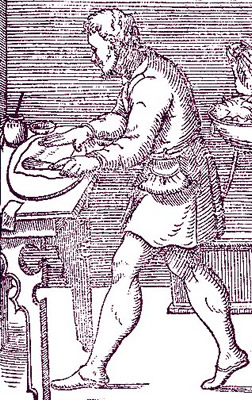
Spreading Plasters, From Chirugiae, By
Giovanni Andrea Della Croce, The
Wellcome Collection (1573)
- Emplastrum de Minio or red lead plaster was said to disperse humors at the wound site, ease pain, repel the inflow of unwanted humors ('somewhat') and was useful in healing wounds and ulcers.8
- Emplastrum Stipticum Paracelsi or the Paracelsus plaster was said to be most useful in wounds which pierced the skin, defending the wound from unwanted humors, dispersing those humors, mollifying pain, encouraging the growth of flesh in deep wounds and helping old aches.9
- Emplastrum de Lapide Calminari or 'Grisium' was valuable for healing ulcers and venereal buboes (inflamed lymph nodes) as well as being "the best incarnative [flesh regenerating medicine] of all the Plasters that ever I used."10
- Emplastrum Diachalcitoes eased pain, repelled venereal humors, caused the growth of new flesh in wounds and was thought to be useful in problems of the kidneys.11
- Emplastrum Diapalma "cures green [fresh] wounds, pestilent tumours and exitores [probably exitours - running sores]; as also Ulcers, Bruises and divelled [split or pulled open] parts."12
- Emplastrum Basilicum or Unguentum Basilicon promoted the growth of healthy flesh in wounds and ulcers, caused suppuration (the generation of pus, thought to be unwanted humors being removed from the wound site), cleansed ulcers and eased pain.13
- Emplastrum de Betonica or Plaster of Betony was for drawing pieces of bone out of wound, generating flesh in them, cleansing and drying wounds.14
The similarity between these medicines is notable. However, based on their descriptions, they would have served the purpose of the first aid type kit admirably.
1 Thomas Brugis, Vade Mecum, 1689, p. 2; 2 John Woodall, the surgions mate, 1617, p. 25; 3 James Cooke, Supplementum chirurgiae and the Military Chest, 1655, p. 424; 4 Brugis, p. 1; 5 See Randle Holme, The academy of armory, 1688, p. 438, Woodall, p. 2, John Atkins, The Navy Surgeon, 1742, p. 148, John Moyle, The Experienced Chirugion, 1703, p. 46 & James Cooke, Supplementum chirurgiae and the Military Chest, 1655, p. 424; 6,7 Brugis, p. 2; 8 Woodall, p. 29; 9 Woodall, p. 27; 10 Woodall, p. 29; 11 Woodall, p. 28; 12 Jean de Renou, A Medicinal Dispensatory, 1657, p. 722; 13 Woodall, p. 44; 14 Nicholas Culpeper, Pharmacopœia Londinesis, 1720, p. 240

